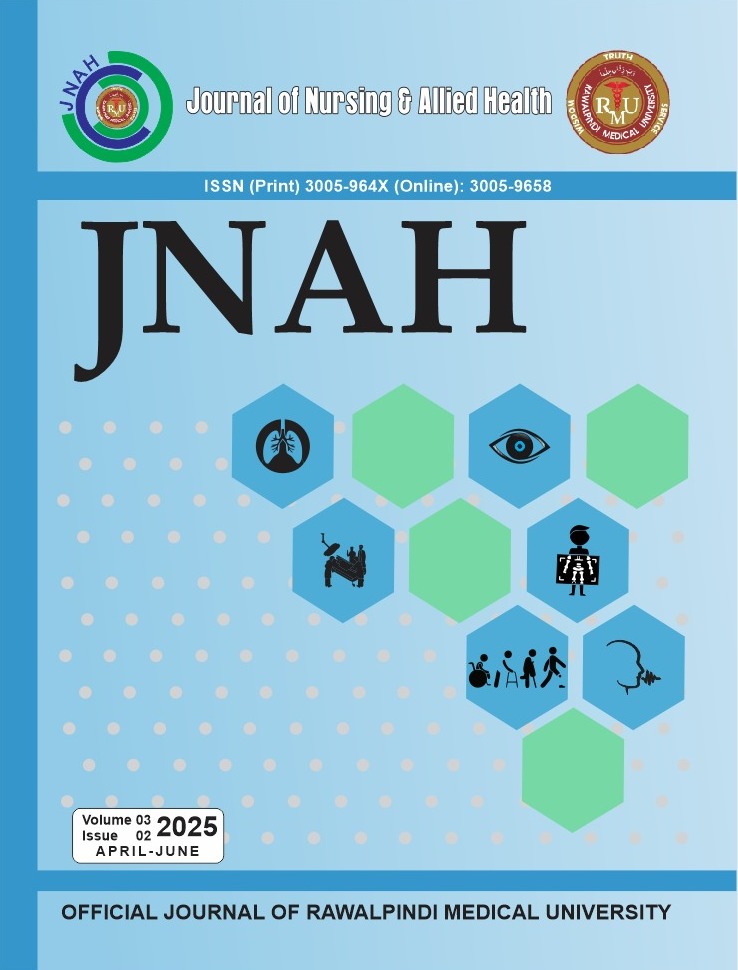Abstract
Objective: To determine the frequency and severity of restless leg syndrome in healthcare professionals.
Study design: It was a descriptive cross sectional study.
Place and duration of study: The study was conducted in hospitals and clinics of Rawalpindi and Islamabad from March 2022 to July 2023.
Material and Methods: This descriptive cross-sectional study was conducted among healthcare professionals, including physicians, nurses, dentists and physiotherapists of age 22- 91 years. After obtaining written consent, the participants were evaluated using the five-point diagnostic criteria of the International Restless Leg Syndrome Study Group to determine the frequency of RLS symptoms. Participants who were tested positive for RLS then completed the Restless Leg Syndrome Rating Scale to assess the severity of symptoms. The data was analyzed using SPSS version 21.0.
Results: The study included 375 healthcare professionals, with 61% being female and 39% male. According to analysis 19.2% of participants displayed symptoms of restless leg syndrome, out of these 5.3% experienced mild symptoms, moderate symptoms were recorded in 9.6% professionals and 4.3% reported severe symptoms. Most individuals with RLS had mild to moderate symptoms and a healthy BMI. Additionally, the study recorded higher prevalence of moderate symptoms of RLS in professional with more standing hours.
Conclusion: This study concluded that frequency of restless leg syndrome (RLS) is less among health care professionals in Rawalpindi and Islamabad. Severity of RLS is mild to moderate.
Keywords: Restless leg syndrome, International restless leg syndrome diagnostic criteria, Restless leg syndrome rating scale.
References
Qureshi MF ASDFDARAAAIAZAIASAPR RLS among HS of KarachiSDisorders 2020;2020:1 5. Prevalence Rate of Restless Leg Syndrome among Healthcare Students of Karachi. Liaquat National Journal of Primary Care. 2020;
Allen RP, Picchietti D, Hening WA, Trenkwalder C, Walters AS, Montplaisi J, et al. Restless legs syndrome: Diagnostic criteria, special considerations, and epidemiology. A report from the restless legs syndrome diagnosis and epidemiology workshop at the National Institutes of Health. Sleep Med. 2003;4(2):101–19.
Waage S, Pallesen S, Moen BE, Bjorvatn B. Restless legs syndrome/Willis-Ekbom disease is prevalent in working nurses, but seems not to be associated with shift work schedules. Front Neurol. 2018 Jan 29;9(JAN).
Mahmood K, Farhan R, Surani A, Surani AA, Surani S. Restless Legs Syndrome among Pakistani Population: A Cross-Sectional Study. Int Sch Res Notices. 2015 Jan 27;2015:1–5.
Kutner NG, Zhang R, Huang Y, Bliwise DL. Racial di-erences in restless legs symptoms and serum ferritin in an incident dialysis patient cohort Nephrology-Original Paper International Urology and Nephrology. 2012.
Rangarajan S, Rangarajan S, D’Souza GA. Restless legs syndrome in an Indian urban population. Sleep Med. 2007 Dec;9(1):88– 93.
Ohayon MM, O’Hara R, Vitiello M V. Epidemiology of restless legs syndrome: A synthesis of the literature. Vol. 16, Sleep Medicine Reviews. 2012. p. 283–95.
Bogan RK. Neuropsychiatric Disease and Treatment Effects of restless legs syndrome (RLS) on sleep. 2022
Gupta R, Dhyani M, Kendzerska T, Pandi- Perumal SR, Bahammam AS, Srivanitchapoom P, et al. Restless legs syndrome and pregnancy: Prevalence, possible pathophysiological mechanisms and treatment. Vol. 133, Acta Neurologica Scandinavica. Blackwell Publishing Ltd; 2016. p. 320–9.
Xiong L, Montplaisir J, Desautels A, Barhdadi A, Turecki G, Levchenko A, et al. Family study of restless legs syndrome in Quebec, Canada: Clinical characterization of 671 familial cases. Arch Neurol. 2010 May;67(5):617–22.
Oka Y, Ioue Y. [Secondary restless legs] Author Information
Ameri M, Mirhosseini S, Basirinezhad MH, Ebrahimi H. Prevalence of restless legs syndrome and its relationship with fatigue in critical care nurses. Indian Journal of Critical Care Medicine. 2021 Nov 1;25(11):1275–9.
Allen RP, Picchietti DL, Garcia-Borreguero D, Ondo WG, Walters AS, Winkelman JW, et al. Restless legs syndrome/Willis-Ekbom disease diagnostic criteria: Updated International Restless Legs Syndrome Study Group (IRLSSG) consensus criteria - history, rationale, description, and significance. Sleep Med. 2014;15(8):860–73.
Abetz L, Arbuckle R, Allen RP, Garcia- Borreguero D, Hening W, Walters AS, et al. The reliability, validity and responsiveness of the International Restless Legs Syndrome Study Group rating scale and subscales in a clinical-trial setting. Sleep Med. 2006 Jun;7(4):340–9.
Zunisha Bukhari S, Asim Arif M, asad Ullah Arsalan syed, komal khan A. Restless Leg Syndrome: A Cross Sectional Study on Nurses.
Davaadorj A, Byambajav P, Munkhsukh MU, Och M, Zorigt S, Boldbaatar D, et al. Prevalence of restless leg syndrome in Mongolian adults: Mon-TimeLine study. Vol. 20, Journal of Integrative Neuroscience. IMR Press Limited; 2021. p. 405–9.
Wali SO, Abaalkhail B. Prevalence of restless legs syndrome and associated risk factors among middle-aged Saudi population. Ann Thorac Med. 2015 Jul 1;10(3):193–8.
Ishaq M, Riaz S, Iqbal N, Siddiqui S, Moin A, Sajjad S, et al. Prevalence of restless legs syndrome among medical students of Karachi: an experience from a developing country. Sleep Disorders. 2020;2020. Coombes BK, Bisset L, Vicenzino B. Management of lateral elbow tendinopathy: One size does not fit all. J Orthop Sports Phys Ther. 2015;45(11):938-949.

This work is licensed under a Creative Commons Attribution-ShareAlike 4.0 International License.
Copyright (c) 2025 Journal of Nursing and Allied Health

